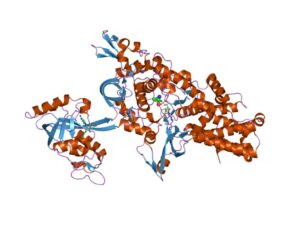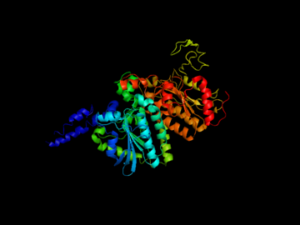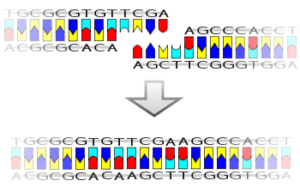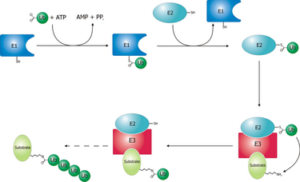The word “ligase” means to join or to bind. It catalyses the joining of two macro-molecules by forming new bonds, such as bonds between C-O, C-N, C-S, etc.
- Aminoacyl-tRNA ligases
- Acid-Ethanol ligases
- Olefin beta-lactone synthetase
- Acid-thiol ligases
- Acid-ammonia ligases
- Peptide synthases
- Cyclo ligases
- NAD+ synthase
- Phosphoribosylformylglycinamidine synthase
- Asparagine synthase
- Carbamoyl-phosphate synthase
- Asparaginyl-tRNA synthase
- Glutaminyl-tRNA synthase
- Pyruvate carboxylase
- Acetyl-CoA carboxylase
- Propionyl-CoA carboxylase
- Methylcrotonoyl-CoA carboxylase
- Geranoyl-CoA carboxylase
- Acetone-carboxylase
- 2-oxoglutarate carboxylase
- Coenzyme F430 synthetase
- DNA ligases
- RNA ligases
- Magnesium Chelatase
- Cobaltochelatases
- Ubiquitin Ligases
Ligase belongs to one of the six classes of Enzymes (Enzymatic classification/EC:6).
In biology, the ligase enzyme is also referred to as “molecular glue” due to its property of joining DNA fragments by catalysing the formation of a phosphodiester bond.
Let’s see some of the Ligase enzyme examples.
1. Aminoacyl-tRNA ligases
The carbon-oxygen bond is formed between Aminoacyl-tRNA. This enzyme is vital for the translation of proteins on ribosomes using tRNA. Here “aminoacyl” refers to an individual amino acid. There are about 25 aminoacyl-tRNA ligases.

Wikipedia
2. Acid-Ethanol Ligases
The carbon-oxygen bond is formed between acid and OH groups. The ligase enzyme under this category is also called ester synthases. The word synthases depict that the reaction here can be catalysed without the use oF ATP/energy expenditure
3. Olefin beta-lactone synthetases
This enzyme is found in the biosynthesis pathway of olefinic hydrocarbons.
4. Acid-Thiol Ligases
Acid-thiol ligases, as the name suggests, the bond is formed between the carbon of the acid group and sulphur of a thiol group. These enzymes are mainly involved in fatty acid synthesis and secondary metabolites in living beings.
5. Acid-Ammonia Ligases
They are broadly known as amide synthases. It catalyses the ligation reaction between an acid and ammonia by forming a bond between carbon and nitrogen.
6. Peptide Synthases
Peptide Ligases are also called because they catalyse the bond formation between peptides and proteins and some specific substrate. The bond is formed between carbon and nitrogen
7. Cyclo Ligases
They catalyse the formation of carbon-nitrogen bonds within a molecule, thus giving rise to a heterocyclic ring.
8. NAD+ Synthases
It is short for Nicotine adenine dinucleotide synthases. The carbon-nitrogen bond is formed between three important substrates: ATP, NAD, and ammonia.
9. Phosphoribosylformylglycineamide Synthases
It catalyses the reaction by forming a carbon-nitrogen bond, where the donor molecule is Glutamine.
10. Aspargine Synthases
It is one of the housekeeping enzymes in mammals. It is physiologically essential and is involved in the Urea cycle, where it catalyses the conversion of aspartate to asparagine.
11. Carbamoyl-phosphate Synthases
It catalyses the formation of carbomyl phosphate, which is a crucial step in pyrimidine and arginine biosynthesis.
12. Asparginyl-tRNA Synthase
It forms a carbon-oxygen bond to produce L-aspargine. It is also involved in the metabolism of aspartate and alanine.
13. Glutaminyl-tRNA Synthase
It is among the twenty t-RNA synthases involved in the formation of Glutamine.
14. Pyruvate Carboxylases
It is an essential enzyme of Kreb’s cycle where it catalyses the formation of oxaloacetate.
15. Acetyl-CoA Carboxylases
It catalyses an irreversible reaction of carboxyltransferase to form malonyl-CoA.

Wikipedia
16. Propionyl-CoA Carboxylases
It is short for PCC. Dysfunction of this enzyme leads to metabolic acidosis.
17. Methylcrotonoyl-CoA Carboxylases
It catalyses ATP dependent carboxylation of 3-methylcrotonoyl-CoA. The deficiency of this enzyme causes Methylcrotonylglycinuria.
18. Geranoyl Carboxylases
It is biotin containing carboxylase enzyme. Mainly reported in plants and bacteria.
19. Acetone Carboxylases
It is a type of ATP-dependent carboxylase which catalyses the bond formation between its acetone substrate and bicarbonate ion
20. 2-Oxoglutarate Carboxylase
As the name suggests, it assists in bond formation between 2-oxoglutarate and a bicarbonate ion in the presence of ATP.
21. Coenzyme F430 Synthetases
This enzyme has the characteristic feature of containing a tetrapyrrole-derived centre.
22. DNA Ligases
It uses ATP or NAD+ to form a phosphodiester bond between two bases in DNA.

Wikipedia
23. RNA Ligases
It forms the bond between the 3′ hydroxyl group and the 5′ phosphate group of the RNA molecules. And for this reaction, it needs ATP, which is converted to AMP.
24. Magnesium Chelatase
Its primary role is in the synthesis of chlorophyll and bacteriochlorophyll. It assists in inserting magnesium ions into the porphyrin complex nine core.

Wikipedia
25. Cobaltochelatases
It forms nitrogen-D-metal bonds. It plays a centric role in the biosynthetic pathway of Vitamin B-12.
26. Ubiquitin Ligases
This ligase enables the transfer of Ubiquitin from a carrier molecule to a protein substrate. There are different types of ubiquitin ligases which are substrate-specific.

Summary
Our post summarised different Ligase enzyme examples based on their specificity for substrates and the bond formation catalysed by the ligase enzyme. It can be concluded that the ligase enzyme is found throughout living organisms and has applications in biotechnology and industrial research.
Also Read:
- Commensalism examples
- Plant cell mitochondria functions
- Are carrier proteins active
- Meiosis stages 2
- Nucleotide examples
- Do bacteria have chloroplasts
- Fungi chromosome structure
- Transferase enzyme examples
- Water movement through cell wall
- Does endoplasmic reticulum have membrane
Hi…..I am Parul Jain, I have completed my Master’s in Biotechnology. I always like to explore new areas in the field of Biotechnology.
Apart from this, I like to read and travel.